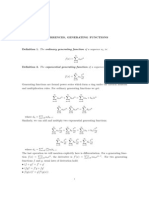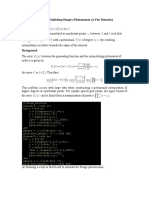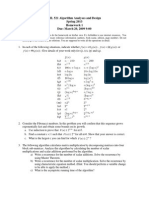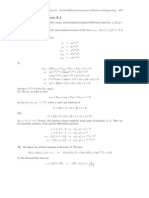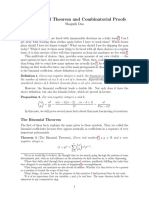Generating Functions
Uploaded by
computerstudentGenerating Functions
Uploaded by
computerstudentGENERATING FUNCTIONS AND RECURRENCE
RELATIONS
Generating Functions
Recurrence Relations
Suppose a
0
, a
1
, a
2
, . . . , a
n
, . . . ,is an innite sequence.
A recurrence recurrence relation is a set of equations
a
n
= f
n
(a
n1
, a
n2
, . . . , a
nk
). (1)
The whole sequence is determined by (1) and the values of
a
0
, a
1
, . . . , a
k1
.
Generating Functions
Linear Recurrence
Fibonacci Sequence
a
n
= a
n1
+ a
n2
n 2.
a
0
= a
1
= 1.
Generating Functions
b
n
= |B
n
| = |{x {a, b, c}
n
: aa does not occur in x}|.
b
1
= 3 : a b c
b
2
= 8 : ab ac ba bb bc ca cb cc
b
n
= 2b
n1
+ 2b
n2
n 2.
Generating Functions
b
n
= 2b
n1
+ 2b
n2
n 2.
Let
B
n
= B
(b)
n
B
(c)
n
B
(a)
n
where B
()
n
= {x B
n
: x
1
= } for = a, b, c.
Now |B
(b)
n
| = |B
(c)
n
| = |B
n1
|. The map f : B
(b)
n
B
n1
,
f (bx
2
x
3
. . . x
n
) = x
2
x
3
. . . x
n
is a bijection.
B
(a)
n
= {x B
n
: x
1
= a and x
2
= b or c}. The map
g : B
(a)
n
B
(b)
n1
B
(c)
n1
,
g(ax
2
x
3
. . . x
n
) = x
2
x
3
. . . x
n
is a bijection.
Hence, |B
(a)
n
| = 2|B
n2
|.
Generating Functions
Towers of Hanoi
Peg 1
Peg 2 Peg 3
H
n
is the minimum number of moves needed to shift
n rings from Peg 1 to Peg 2. One is not allowed to
place a larger ring on top of a smaller ring.
Generating Functions
Hn-1 moves
1 move
Hn-1 moves
H
n
= 2H
n1
+ 1
Generating Functions
A has n dollars. Everyday A buys one of a Bun (1 dollar), an
Ice-Cream (2 dollars) or a Pastry (2 dollars). How many ways
are there (sequences) for A to spend his money?
Ex. BBPIIPBI represents Day 1, buy Bun. Day 2, buy Bun etc..
u
n
= number of ways
= u
n,B
+ u
n,I
+ u
n,P
where u
n,B
is the number of ways where A buys a Bun on day
1 etc.
u
n,B
= u
n1
, u
n,I
= u
n,P
= u
n2
.
So
u
n
= u
n1
+ 2u
n2
,
and
u
0
= u
1
= 1.
Generating Functions
If a
0
, a
1
, . . . , a
n
is a sequence of real numbers then its
(ordinary) generating function a(x) is given by
a(x) = a
0
+ a
1
x + a
2
x
2
+ a
n
x
n
+
and we write
a
n
= [x
n
]a(x).
Generating Functions
a
n
= 1
a(x) =
1
1 x
= 1 + x + x
2
+ + x
n
+
a
n
= n + 1.
a(x) =
1
(1 x)
2
= 1 + 2x + 3x
2
+ + (n + 1)x
n
+
a
n
= n.
a(x) =
x
(1 x)
2
= x + 2x
2
+ 3x
3
+ + nx
n
+
Generating Functions
Generalised binomial theorem:
a
n
=
_
n
_
a(x) = (1 + x)
n=0
_
n
_
x
n
.
where
_
n
_
=
( 1)( 2) ( n + 1)
n!
.
a
n
=
_
m+n1
n
_
a(x) =
1
(1 x)
m
=
n=0
_
m
n
_
(x)
n
=
n=0
_
m + n 1
n
_
x
n
.
Generating Functions
General view.
Given a recurrence relation for the sequence (a
n
), we
(a) Deduce from it, an equation satised by the generating
function a(x) =
n
a
n
x
n
.
(b) Solve this equation to get an explicit expression for the
generating function.
(c) Extract the coefcient a
n
of x
n
from a(x), by expanding a(x)
as a power series.
Generating Functions
Solution of linear recurrences
a
n
6a
n1
+ 9a
n2
= 0 n 2.
a
0
= 1, a
1
= 9.
n=2
(a
n
6a
n1
+ 9a
n2
)x
n
= 0. (2)
Generating Functions
n=2
a
n
x
n
= a(x) a
0
a
1
x
= a(x) 1 9x.
n=2
6a
n1
x
n
= 6x
n=2
a
n1
x
n1
= 6x(a(x) a
0
)
= 6x(a(x) 1).
n=2
9a
n2
x
n
= 9x
2
n=2
a
n2
x
n2
= 9x
2
a(x).
Generating Functions
a(x) 1 9x 6x(a(x) 1) + 9x
2
a(x) = 0
or
a(x)(1 6x + 9x
2
) (1 + 3x) = 0.
a(x) =
1 + 3x
1 6x + 9x
2
=
1 + 3x
(1 3x)
2
=
n=0
(n + 1)3
n
x
n
+ 3x
n=0
(n + 1)3
n
x
n
=
n=0
(n + 1)3
n
x
n
+
n=0
n3
n
x
n
=
n=0
(2n + 1)3
n
x
n
.
a
n
= (2n + 1)3
n
.
Generating Functions
Fibonacci sequence:
n=2
(a
n
a
n1
a
n2
)x
n
= 0.
n=2
a
n
x
n
n=2
a
n1
x
n
n=2
a
n2
x
n
= 0.
(a(x) a
0
a
1
x) (x(a(x) a
0
)) x
2
a(x) = 0.
a(x) =
1
1 x x
2
.
Generating Functions
a(x) =
1
(
1
x)(
2
x)
=
1
1
2
_
1
1
x
1
2
x
_
=
1
1
2
_
1
1
1 x/
1
1
2
1 x/
2
_
where
1
=
5 + 1
2
and
2
=
5 1
2
are the 2 roots of
x
2
+ x 1 = 0.
Generating Functions
Therefore,
a(x) =
1
1
1
2
n=0
n
1
x
n
1
2
1
2
n=0
n
2
x
n
=
n=0
n1
1
n1
2
1
2
x
n
and so
a
n
=
n1
1
n1
2
1
2
=
1
5
_
_
_
5 + 1
2
_
n+1
_
1
5
2
_
n+1
_
_
.
Generating Functions
Inhomogeneous problem
a
n
3a
n1
= n
2
n 1.
a
0
= 1.
n=1
(a
n
3a
n1
)x
n
=
n=1
n
2
x
n
n=1
n
2
x
n
=
n=2
n(n 1)x
n
+
n=1
nx
n
=
2x
2
(1 x)
3
+
x
(1 x)
2
=
x + x
2
(1 x)
3
n=1
(a
n
3a
n1
)x
n
= a(x) 1 3xa(x)
= a(x)(1 3x) 1.
Generating Functions
a(x) =
x + x
2
(1 x)
3
(1 3x)
+
1
1 3x
=
A
1 x
+
B
(1 x)
2
+
C
(1 x)
3
+
D + 1
1 3x
where
x + x
2
= A(1 x)
2
(1 3x) + B(1 x)(1 3x)
+ C(1 3x) + D(1 x)
3
.
Then
A = 1/2, B = 0, C = 1, D = 3/2.
Generating Functions
So
a(x) =
1/2
1 x
1
(1 x)
3
+
5/2
1 3x
=
1
2
n=0
x
n
n=0
_
n + 2
2
_
x
n
+
5
2
n=0
3
n
x
n
So
a
n
=
1
2
_
n + 2
2
_
+
5
2
3
n
=
3
2
3n
2
n
2
2
+
5
2
3
n
.
Generating Functions
General case of linear recurrence
a
n
+ c
1
a
n1
+ + c
k
a
nk
= u
n
, n k.
u
0
, u
1
, . . . , u
k1
are given.
(a
n
+ c
1
a
n1
+ + c
k
a
nk
u
n
) x
n
= 0
It follows that for some polynomial r (x),
a(x) =
u(x) + r (x)
q(x)
where
q(x) = 1 + c
1
x + c
2
x
2
+ + c
k
x
k
=
k
i =1
(1
i
x)
and
1
,
2
, . . . ,
k
are the roots of p(x) = 0 where
p(x) = x
k
q(1/x) = x
k
+ c
1
x
k1
+ + c
0
.
Generating Functions
Products of generating functions
a(x) =
n=0
a
n
x
n
, b(x)) =
n=0
b
n
x
n
.
a(x)b(x) = (a
0
+ a
1
x + a
2
x
2
+ )
(b
0
+ b
1
x + b
2
x
2
+ )
= a
0
b
0
+ (a
0
b
1
+ a
1
b
0
)x +
(a
0
b
2
+ a
1
b
1
+ a
2
b
0
)x
2
+
=
n=0
c
n
x
n
where
c
n
=
n
k=0
a
k
b
nk
.
Generating Functions
Derangements
n! =
n
k=0
_
n
k
_
d
nk
.
Explanation:
_
n
k
_
d
nk
is the number of permutations with
exactly k cycles of length 1. Choose k elements (
_
n
k
_
ways) for
which (i ) = i and then choose a derangement of the
remaining n k elements.
So
1 =
n
k=0
1
k!
d
nk
(n k)!
n=0
x
n
=
n=0
_
n
k=0
1
k!
d
nk
(n k)!
_
x
n
. (3)
Generating Functions
Let
d(x) =
m=0
d
m
m!
x
m
.
From (3) we have
1
1 x
= e
x
d(x)
d(x) =
e
x
1 x
=
n=0
n
k=0
_
(1)
k
k!
_
x
n
.
So
d
n
n!
=
n
k=0
(1)
k
k!
.
Generating Functions
Triangulation of n-gon
Let
a
n
= number of triangulations of P
n+1
=
n
k=0
a
k
a
nk
n 2 (4)
a
0
= 0, a
1
= a
2
= 1.
+1
1
n+1
k
Generating Functions
Explanation of (4):
a
k
a
nk
counts the number of triangulations in which edge
1, n + 1 is contained in triangle 1, k + 1, n + 1.
There are a
k
ways of triangulating 1, 2, . . . , k + 1, 1 and for
each such there are a
nk
ways of triangulating
k + 1, k + 2, . . . , n + 1, k + 1.
Generating Functions
x +
n=2
a
n
x
n
= x +
n=2
_
n
k=0
a
k
a
nk
_
x
n
.
But,
x +
n=2
a
n
x
n
= a(x)
since a
0
= 0, a
1
= 1.
n=2
_
n
k=0
a
k
a
nk
_
x
n
=
n=0
_
n
k=0
a
k
a
nk
_
x
n
= a(x)
2
.
Generating Functions
So
a(x) = x + a(x)
2
and hence
a(x) =
1 +
1 4x
2
or
1
1 4x
2
.
But a(0) = 0 and so
a(x) =
1
1 4x
2
=
1
2
1
2
_
1 +
n=1
(1)
n1
n2
2n1
_
2n 2
n 1
_
(4x)
n
_
=
n=1
1
n
_
2n 2
n 1
_
x
n
.
So
a
n
=
1
n
_
2n 2
n 1
_
.
Generating Functions
Exponential Generating Functions
Given a sequence a
n
, n 0, its exponential generating function
(e.g.f.) a
e
(x) is given by
a
e
(x) =
n=0
a
n
n!
x
n
a
n
= 1, n 0 implies a
e
(x) = e
x
.
a
n
= n!, n 0 implies a
e
(x) =
1
1 x
Generating Functions
Products of Exponential Generating Functions
Let a
e
(x), b
e
(x) be the e.g.f.s respectively for (a
n
), (b
n
)
respectively. Then
c
e
(x) = a
e
(x)b
e
(x) =
n=0
_
n
k=0
a
k
k!
b
nk
(n k)!
_
x
n
=
n
k=0
c
n
n!
x
n
where
c
n
=
_
n
k
_
a
k
b
nk
.
Generating Functions
Interpretation
Suppose that we have a collection of labelled objects and each
object has a size k, where k is a non-negative integer. Each
object labelled by a set of size k.
Suppose that the number of labelled objects of size k is a
k
.
Examples:
(a): Each object is a directed path with k vertices and its
vertices are labelled by 1, 2, . . . , k in some order. Thus a
k
= k!.
(b): Each object is a directed cycle with k vertices and its
vertices are labelled by 1, 2, . . . , k in some order. Thus
a
k
= (k 1)!.
Generating Functions
Now take example (a) and let a
e
(x) =
1
1x
be the e.g.f. of this
family. Now consider
c
e
(x) = a
e
(x)
2
=
n=0
(n + 1)x
n
with c
n
= (n + 1) n!.
c
n
is the number of ways of choosing an object of weight k and
another object of weight n k and a partition of [n] into two
sets A
1
, A
2
of size k and labelling the rst object with A
1
and
the second with A
2
.
Here (n +1) n! represents taking a permutation and choosing
0 k n and putting the rst k labels onto the rst path and
the second n k labels onto the second path.
Generating Functions
We will now use this machinery to count the number s
n
of
permutations that have an even number of cycles all of which
have odd lengths:
Cycles of a permutation
Let : D D be a permutation of the nite set D. Consider the
digraph
= (D, A) where A = {(i , (i )) : i D}.
is a
collection of vertex disjoint cycles. Each x D being on a
unique cycle. Here a cycle can consist of a loop i.e. when
(x) = x.
Example: D = [10].
i 1 2 3 4 5 6 7 8 9 10
(i ) 6 2 7 10 3 8 9 1 5 4
The cycles are (1, 6, 8), (2), (3, 7, 9, 5), (4, 10).
Generating Functions
In general consider the sequence i , (i ),
2
(i ), . . . ,.
Since D is nite, there exists a rst pair k < such that
k
(i ) =
(i ). Now we must have k = 0, since otherwise putting
x =
k1
(i ) = y =
1
(i ) we see that (x) = (y),
contradicting the fact that is a permutation.
So i lies on the cycle C = (i , (i ),
2
(i ), . . . ,
k1
(i ), i ).
If j is not a vertex of C then (j ) is not on C and so we can
repeat the argument to show that the rest of D is partitioned
into cycles.
Generating Functions
Now consider
a
e
(x) =
m=0
(2m)!
(2m + 1)!
x
2m+1
Here
a
n
=
_
0 n is even
(n 1)! n is odd
Thus each object is an odd length cycle C, labelled by [|C|].
Note that
a
e
(x) =
_
x +
x
2
2
+
x
3
3
+
x
4
4
+
_
_
x
2
2
+
x
4
4
+
_
= log
_
1
1 x
_
1
2
log
_
1
1 x
2
_
= log
_
1 + x
1 x
_
Generating Functions
Now consider a
e
(x)
. The coefcient of x
n
in this series is
c
n
n!
where c
n
is the number of ways of choosing an ordered
sequence of cycles of lengths a
1
, a
2
, . . . , a
where
a
1
+ a
2
+ + a
= n. And then a partition of [n] into
A
1
, A
2
, . . . , A
where |A
i
| = a
i
for i = 1, 2, . . . , . And then
labelling the i th cycle with A
i
for i = 1, 2, . . . , .
We looked carefully at the case = 2 and this needs a simple
inductive step.
It follows that the coefcient of x
n
in
a
e
(x)
!
is
c
n
n!
where c
n
is the
number of ways of choosing a set (unordered sequence) of
cycles of lengths a
1
, a
2
, . . . , a
. . .
What we therefore want is the coefcient of x
n
in
1 +
a
e
(x)
2
2!
+
a(x)
4
4!
+ .
Generating Functions
Now
k=0
a
e
(x)
2k
k!
=
e
a
e
(x)
+ e
a
e
(x)
2
=
1
2
_
_
1 + x
1 x
+
_
1 x
1 + x
_
=
1
1 x
2
Thus
s
n
= n![x
n
]
1
1 x
2
=
_
n
n/2
_
n!
2
n
Generating Functions
You might also like
- Hourglass Workout Program by Luisagiuliet 276% (21)Hourglass Workout Program by Luisagiuliet 251 pages
- The Hold Me Tight Workbook - Dr. Sue Johnson100% (16)The Hold Me Tight Workbook - Dr. Sue Johnson187 pages
- Read People Like A Book by Patrick King-Edited62% (66)Read People Like A Book by Patrick King-Edited12 pages
- Livingood, Blake - Livingood Daily Your 21-Day Guide To Experience Real Health77% (13)Livingood, Blake - Livingood Daily Your 21-Day Guide To Experience Real Health260 pages
- COSMIC CONSCIOUSNESS OF HUMANITY - PROBLEMS OF NEW COSMOGONY (V.P.Kaznacheev,. Л. V. Trofimov.)94% (212)COSMIC CONSCIOUSNESS OF HUMANITY - PROBLEMS OF NEW COSMOGONY (V.P.Kaznacheev,. Л. V. Trofimov.)212 pages
- Donald Trump & Jeffrey Epstein Rape Lawsuit and Affidavits83% (1016)Donald Trump & Jeffrey Epstein Rape Lawsuit and Affidavits13 pages
- The 36 Questions That Lead To Love - The New York Times94% (34)The 36 Questions That Lead To Love - The New York Times3 pages
- The 36 Questions That Lead To Love - The New York Times95% (21)The 36 Questions That Lead To Love - The New York Times3 pages
- Jeffrey Epstein39s Little Black Book Unredacted PDF75% (12)Jeffrey Epstein39s Little Black Book Unredacted PDF95 pages
- The 4 Hour Workweek, Expanded and Updated by Timothy Ferriss - Excerpt23% (954)The 4 Hour Workweek, Expanded and Updated by Timothy Ferriss - Excerpt38 pages
- Robert Lee & Peter Tryde - Timing Solutions For Swing Traders A Novel Approach To Successful Trading Using Technical Analysis and Financial Astrology 2012No ratings yetRobert Lee & Peter Tryde - Timing Solutions For Swing Traders A Novel Approach To Successful Trading Using Technical Analysis and Financial Astrology 2012241 pages
- Robert Lee & Peter Tryde - Timing Solutions For Swing Traders A Novel Approach To Successful Trading Using Technical Analysis and Financial Astrology 2012No ratings yetRobert Lee & Peter Tryde - Timing Solutions For Swing Traders A Novel Approach To Successful Trading Using Technical Analysis and Financial Astrology 2012241 pages
- 9D25103 Software Requirements and EstimationNo ratings yet9D25103 Software Requirements and Estimation1 page
- 12 International Mathematics Competition For University StudentsNo ratings yet12 International Mathematics Competition For University Students4 pages
- Short Notice On (Exact) Trigonometric InterpolationNo ratings yetShort Notice On (Exact) Trigonometric Interpolation8 pages
- Theoretical Computer Science Cheat SheetNo ratings yetTheoretical Computer Science Cheat Sheet10 pages
- Difference Calculus and Generating Functions. Santos, D. A. 2005100% (1)Difference Calculus and Generating Functions. Santos, D. A. 200534 pages
- Yogesh Meena (BCA-M15 4th SEM) CONM CCENo ratings yetYogesh Meena (BCA-M15 4th SEM) CONM CCE10 pages
- Erum Dost - Simulation of Models Exhibiting Runge's PhenomenonNo ratings yetErum Dost - Simulation of Models Exhibiting Runge's Phenomenon13 pages
- Detailed Solutions A-07 JUNE 2003: I X X F F INo ratings yetDetailed Solutions A-07 JUNE 2003: I X X F F I32 pages
- Eli Maor, e The Story of A Number, Among ReferencesNo ratings yetEli Maor, e The Story of A Number, Among References10 pages
- Solutions To Exercises 8.1: Section 8.1 Partial Differential Equations in Physics and EngineeringNo ratings yetSolutions To Exercises 8.1: Section 8.1 Partial Differential Equations in Physics and Engineering21 pages
- International Competition in Mathematics For Universtiy Students in Plovdiv, Bulgaria 1996No ratings yetInternational Competition in Mathematics For Universtiy Students in Plovdiv, Bulgaria 199615 pages
- Calculus:Nth Differential Coefficient of Standard Functions100% (5)Calculus:Nth Differential Coefficient of Standard Functions14 pages
- Trigonometric Ratios to Transformations (Trigonometry) Mathematics E-Book For Public ExamsFrom EverandTrigonometric Ratios to Transformations (Trigonometry) Mathematics E-Book For Public Exams5/5 (1)
- Inverse Trigonometric Functions (Trigonometry) Mathematics Question BankFrom EverandInverse Trigonometric Functions (Trigonometry) Mathematics Question BankNo ratings yet
- Mathematics 1St First Order Linear Differential Equations 2Nd Second Order Linear Differential Equations Laplace Fourier Bessel MathematicsFrom EverandMathematics 1St First Order Linear Differential Equations 2Nd Second Order Linear Differential Equations Laplace Fourier Bessel MathematicsNo ratings yet
- Hyperbolic Functions (Trigonometry) Mathematics E-Book For Public ExamsFrom EverandHyperbolic Functions (Trigonometry) Mathematics E-Book For Public ExamsNo ratings yet
- Questions and Bits Object Oriented Analysis and Design Venati SudhakarNo ratings yetQuestions and Bits Object Oriented Analysis and Design Venati Sudhakar15 pages
- Review MODULE - MATHEMATICS (Vectors & Analytic Geometry in Three Dimension)No ratings yetReview MODULE - MATHEMATICS (Vectors & Analytic Geometry in Three Dimension)1 page
- Q1: D Definition (Algebraically Closed Field) : Abstract Algebra Root Non-Constant Polynomial Ring of PolynomialsNo ratings yetQ1: D Definition (Algebraically Closed Field) : Abstract Algebra Root Non-Constant Polynomial Ring of Polynomials2 pages
- Arsdigita University Month 2: Discrete Mathematics - Professor Shai Simonson Problem Set 7 - Generating Functions, Number Theory, CryptographyNo ratings yetArsdigita University Month 2: Discrete Mathematics - Professor Shai Simonson Problem Set 7 - Generating Functions, Number Theory, Cryptography2 pages
- Full Download (Ebook) Smooth Compactifications of Locally Symmetric Varieties by Avner Ash, David Mumford, Michael Rapoport, Yung-sheng Tai ISBN 9780521739559, 0521739551, 9780511673540 PDF DOCX100% (1)Full Download (Ebook) Smooth Compactifications of Locally Symmetric Varieties by Avner Ash, David Mumford, Michael Rapoport, Yung-sheng Tai ISBN 9780521739559, 0521739551, 9780511673540 PDF DOCX82 pages
- The Binomial Theorem and Combinatorial Proofs: Shagnik DasNo ratings yetThe Binomial Theorem and Combinatorial Proofs: Shagnik Das4 pages
- Livingood, Blake - Livingood Daily Your 21-Day Guide To Experience Real HealthLivingood, Blake - Livingood Daily Your 21-Day Guide To Experience Real Health
- COSMIC CONSCIOUSNESS OF HUMANITY - PROBLEMS OF NEW COSMOGONY (V.P.Kaznacheev,. Л. V. Trofimov.)COSMIC CONSCIOUSNESS OF HUMANITY - PROBLEMS OF NEW COSMOGONY (V.P.Kaznacheev,. Л. V. Trofimov.)
- Donald Trump & Jeffrey Epstein Rape Lawsuit and AffidavitsDonald Trump & Jeffrey Epstein Rape Lawsuit and Affidavits
- The 36 Questions That Lead To Love - The New York TimesThe 36 Questions That Lead To Love - The New York Times
- The 36 Questions That Lead To Love - The New York TimesThe 36 Questions That Lead To Love - The New York Times
- Jeffrey Epstein39s Little Black Book Unredacted PDFJeffrey Epstein39s Little Black Book Unredacted PDF
- The 4 Hour Workweek, Expanded and Updated by Timothy Ferriss - ExcerptThe 4 Hour Workweek, Expanded and Updated by Timothy Ferriss - Excerpt
- Robert Lee & Peter Tryde - Timing Solutions For Swing Traders A Novel Approach To Successful Trading Using Technical Analysis and Financial Astrology 2012Robert Lee & Peter Tryde - Timing Solutions For Swing Traders A Novel Approach To Successful Trading Using Technical Analysis and Financial Astrology 2012
- Robert Lee & Peter Tryde - Timing Solutions For Swing Traders A Novel Approach To Successful Trading Using Technical Analysis and Financial Astrology 2012Robert Lee & Peter Tryde - Timing Solutions For Swing Traders A Novel Approach To Successful Trading Using Technical Analysis and Financial Astrology 2012
- 12 International Mathematics Competition For University Students12 International Mathematics Competition For University Students
- Short Notice On (Exact) Trigonometric InterpolationShort Notice On (Exact) Trigonometric Interpolation
- Difference Calculus and Generating Functions. Santos, D. A. 2005Difference Calculus and Generating Functions. Santos, D. A. 2005
- Erum Dost - Simulation of Models Exhibiting Runge's PhenomenonErum Dost - Simulation of Models Exhibiting Runge's Phenomenon
- Eli Maor, e The Story of A Number, Among ReferencesEli Maor, e The Story of A Number, Among References
- Solutions To Exercises 8.1: Section 8.1 Partial Differential Equations in Physics and EngineeringSolutions To Exercises 8.1: Section 8.1 Partial Differential Equations in Physics and Engineering
- International Competition in Mathematics For Universtiy Students in Plovdiv, Bulgaria 1996International Competition in Mathematics For Universtiy Students in Plovdiv, Bulgaria 1996
- Calculus:Nth Differential Coefficient of Standard FunctionsCalculus:Nth Differential Coefficient of Standard Functions
- Trigonometric Ratios to Transformations (Trigonometry) Mathematics E-Book For Public ExamsFrom EverandTrigonometric Ratios to Transformations (Trigonometry) Mathematics E-Book For Public Exams
- Inverse Trigonometric Functions (Trigonometry) Mathematics Question BankFrom EverandInverse Trigonometric Functions (Trigonometry) Mathematics Question Bank
- Mathematics 1St First Order Linear Differential Equations 2Nd Second Order Linear Differential Equations Laplace Fourier Bessel MathematicsFrom EverandMathematics 1St First Order Linear Differential Equations 2Nd Second Order Linear Differential Equations Laplace Fourier Bessel Mathematics
- Differentiation (Calculus) Mathematics Question BankFrom EverandDifferentiation (Calculus) Mathematics Question Bank
- Hyperbolic Functions (Trigonometry) Mathematics E-Book For Public ExamsFrom EverandHyperbolic Functions (Trigonometry) Mathematics E-Book For Public Exams
- Questions and Bits Object Oriented Analysis and Design Venati SudhakarQuestions and Bits Object Oriented Analysis and Design Venati Sudhakar
- Review MODULE - MATHEMATICS (Vectors & Analytic Geometry in Three Dimension)Review MODULE - MATHEMATICS (Vectors & Analytic Geometry in Three Dimension)
- Q1: D Definition (Algebraically Closed Field) : Abstract Algebra Root Non-Constant Polynomial Ring of PolynomialsQ1: D Definition (Algebraically Closed Field) : Abstract Algebra Root Non-Constant Polynomial Ring of Polynomials
- Arsdigita University Month 2: Discrete Mathematics - Professor Shai Simonson Problem Set 7 - Generating Functions, Number Theory, CryptographyArsdigita University Month 2: Discrete Mathematics - Professor Shai Simonson Problem Set 7 - Generating Functions, Number Theory, Cryptography
- Full Download (Ebook) Smooth Compactifications of Locally Symmetric Varieties by Avner Ash, David Mumford, Michael Rapoport, Yung-sheng Tai ISBN 9780521739559, 0521739551, 9780511673540 PDF DOCXFull Download (Ebook) Smooth Compactifications of Locally Symmetric Varieties by Avner Ash, David Mumford, Michael Rapoport, Yung-sheng Tai ISBN 9780521739559, 0521739551, 9780511673540 PDF DOCX
- The Binomial Theorem and Combinatorial Proofs: Shagnik DasThe Binomial Theorem and Combinatorial Proofs: Shagnik Das



































